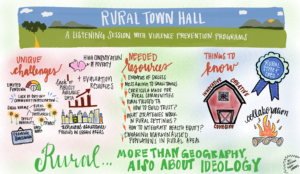Navigating Sexual Violence Prevention in Rural Communities: Challenges, Needs, and Strengths
Sexual violence prevention practitioners are no strangers to the complex landscape of their work, but when it comes to rural communities, the terrain presents unique challenges, needs, and strengths that demand careful navigation and tailored approaches.
The Centers for Disease Control and Prevention’s (CDC) Violence Prevention Practice & Translation Branch recently hosted a Rural Town Hall listening session to hear directly from RPE recipients about these challenges, needs, and strengths around prevention in rural communities. The Town Hall also featured a brief presentation from CDC’s Office of Rural Health who shared about current work and resources to support rural communities.

RPE recipients were candid in sharing about the importance of understanding the social and cultural factors of rural communities, as well as what they need from national technical assistance providers. PreventConnect has distilled the key insights from the Town Hall and organized them into distinct categories, providing a comprehensive overview of the challenges, needs, and strengths facing sexual violence prevention practitioners in rural communities. To view the graphic recording from this event, click here.
Understanding the Landscape: Challenges Faced
Trust and Relationship Building
One of the foremost challenges in rural communities is establishing trust and building relationships. Unlike urban areas where resources and support systems might be more accessible, rural locales often operate within tight-knit networks where outsiders are met with suspicion. This poses a significant barrier for practitioners, especially when it comes to implementing prevention programs.
Limited Funding and Resources
The scarcity of funding is a recurring theme in the realm of rural sexual violence prevention. With smaller populations and fewer resources allocated to these areas, practitioners find themselves grappling with inadequate financial support, hindering their ability to scale and sustain critical programs.
Resistance and Buy-In
Rural communities, often characterized by conservative values and patriarchal norms, may exhibit resistance to acknowledging sexual violence as a prevalent issue. This resistance, coupled with the challenge of garnering buy-in from community members, creates additional hurdles for practitioners seeking to initiate prevention efforts.
Data Accessibility and Evaluation
Access to comprehensive data is another significant obstacle faced by practitioners operating in rural areas. Many counties lack robust data collection mechanisms, making it challenging to assess the effectiveness of prevention strategies and measure outcomes accurately.
Meeting the Needs: Resources and Strategies
Tailored Training and Technical Assistance
Practitioners in rural communities require training and technical assistance specifically tailored to their unique context. Resources designed for urban settings may not always apply, highlighting the need for customized support that addresses the distinct challenges and dynamics of rural environments.
Collaborative Partnerships
Strategies based on collaboration have shown promise in rural settings. By forging partnerships with non-public health entities such as faith communities, sports organizations, and local leaders, practitioners can leverage existing networks and amplify their impact within the community.
Culturally Competent Approaches
Cultural competency is essential when working in rural communities, particularly those with conservative values. Practitioners must be sensitive to local beliefs and norms, adapting their approaches to resonate with community members and facilitate meaningful engagement.
Engaging Marginalized Populations
Engaging with marginalized populations within rural communities requires thoughtful strategies that prioritize health equity. By centering the voices and experiences of marginalized individuals, practitioners can ensure that prevention efforts are truly inclusive and address the intersecting factors contributing to sexual violence.
Leveraging Strengths: Building on Resilience and Creativity
Despite the challenges, rural communities possess inherent strengths that can be leveraged in sexual violence prevention efforts. The resilience and tight-knit nature of these communities offer opportunities for building trust, fostering collaboration, and implementing innovative approaches tailored to local needs.
Sexual violence prevention in rural communities demands a nuanced understanding of the challenges, needs, and strengths unique to these settings and tailored technical assistance resources are needed to support prevention efforts. PreventConnect has plans to curate a guide on prevention resources for rural communities and uplift the stories of prevention happening in rural communities across the country on our podcast.
Are you a prevention practitioner working in a rural community? We’d love to hear from you! Send us an email at info@preventconnect.org.
